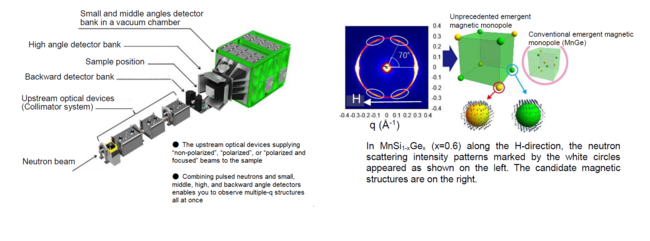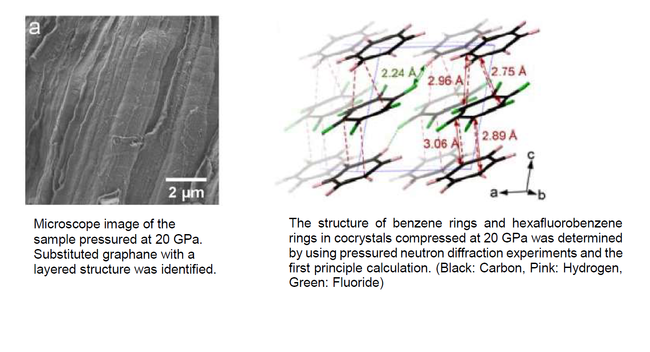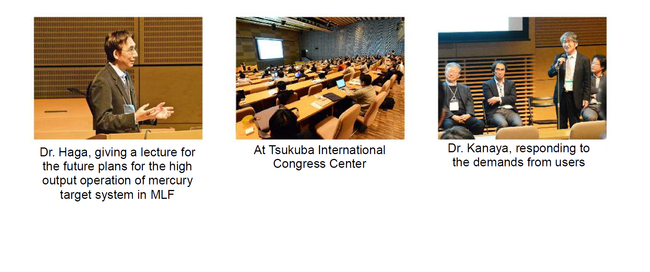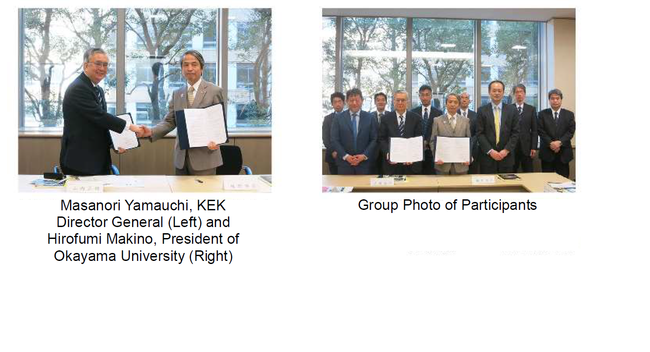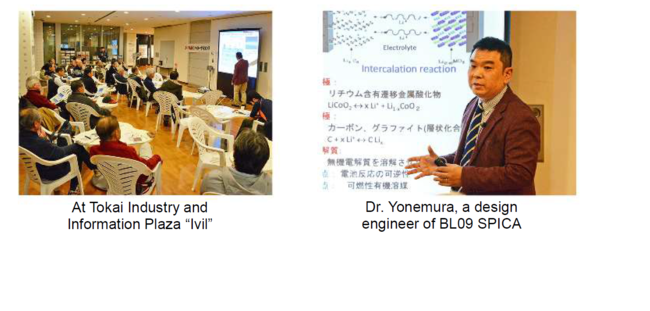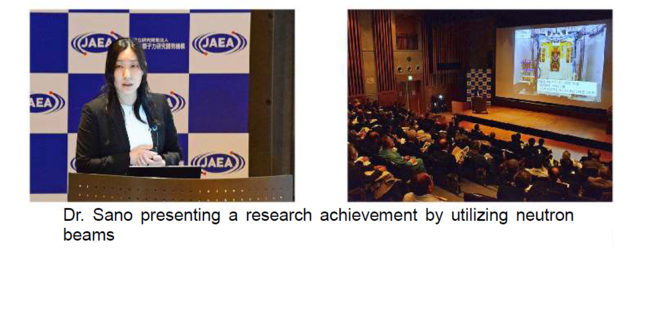J-PARC NEWS March 2019 (Issue #167)
■ KOTO Experiment at J-PARC Hadron Experimental Facility Broke World's Best Sensitivity on Rare Neutral Kaon Decay by an Order of Magnitude - First Step Forward Elucidation of "Matter-Antimatter Asymmetry" - (Press Release on March 4)
Matter and antimatter, both of which are expected to have been created in equal amounts at the very beginning of the universe, will annihilate when they encounter. Recent studies have confirmed that the proven difference in property between matter and antimatter (2008 Physics-Nobel-prize-awarded "Kobayashi-Maskawa theory") only cannot contribute to the sufficient degree of imbalance in the amount of matter and antimatter. In order to solve the riddle of how the present universe consisting of matter was created, we need a new style of physics to find the difference between matter and antimatter. A neutral Kaon (K-meson) decays in various different patterns. One of those is the decay into a neutral π- meson and a pair of neutrinos. This is expected to occur once per 30 billion times provided that the difference between matter and antimatter arises only due to the Kobayashi-Maskawa theory, or the rate is expected to increase several times or several tens of times if there really exists another type of difference due to such new physics. J-PARC has started a new experiment called "KOTO experiment", which allows for creating a huge number of particles in comparison to any conventional accelerator. This time, the experiment successfully showed only in a little over two months, which is less than one tenth of the number of days that conventional accelerators require, that the decay pattern takes place less than once per 300 million times. Sensitivity has increased around 10 times compared to the rate obtained from previous experiments - "less than once per 40 million". At present, the KOTO experiment continues collecting data; more accumulation of data will tell us whether there really exists any deviation from the predictions of the Kobayashi-Maskawa theory.
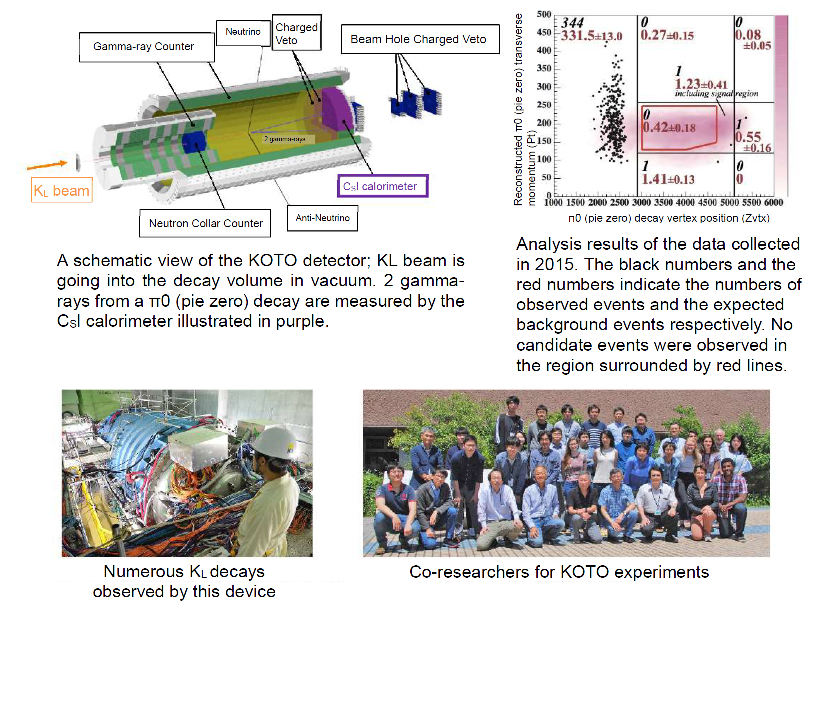
■A New Lattice of Emergent Magnetic Monopoles Appearing in the Course of Phase Transition - Unraveled How Two Topological Magnetic Structures Change - (Press Release on March 5)
A topological magnetic structure, one type of electron-spin ensemble, is currently expected to be applied to new magnetic memory devices that employ geometrical properties of spin arrangement. In this study, regarding MnSi1-xGex , which is a system of MnSi (with a lattice comprising helical spin ensembles) and MnGe (with a lattice comprising spherical spin ensembles: the lattice of emergent magnetic monopoles), samples were prepared by systematically altering the composition ratio of Si and Ge and also measured using J-PARC's TAIKAN, a small and wide-angle neutron scattering instrument. The TAIKAN allows for simultaneous measurement of neutrons scattered at a smaller scattering angle (indicating the size of spin ensembles) and those scattered at a greater scattering angle (indicating the direction of spin ensembles' arrangement), resulting in detailed investigation of such a complicated magnetic structure. The results showed the possibility, in the intermediate composition region where the amounts of Si and Ge become almost the same as each other, of the creation of a new lattice of emergent magnetic monopoles where spherical spin ensembles, which are neither MnSi nor MnGe, are arranged in a face-centered cubic manner (the figure on the right side below). These findings have indicated that effective pressure effects arising from the difference in atomic radius between Si and Ge can achieve the control of topological magnetic structures and therefore, will act as an important guide in the development of any substance with a new topological magnetic ordering.
■Elucidation of the Mechanism of Pressure-Induced Polymerization Reaction of Aromatic Hydrocarbons-Road to the Successful Design of Graphane by Controlling Atomic Species-(Posted on J-PARC Website on March 8)
It is well known that, if aromatic hydrocarbon represented by benzene is subject to a pressure of approximately 20 GPa, certain substances will be formed whose carbon atoms are bonded together as in diamonds. Since those substances have useful properties including high tensile strength and incompressibility, pressure-induced polymerization has been focused on as one of various new polymerization schemes. However, the detailed reaction mechanism has remained unclear to this date. In this study, a benzene crystal partly replaced with hexafluorobenzene (C6F6) was compressed up to 20 GPa and then H-F graphene was terminated with hydrogen and fluorine on its upper side and on its lower side respectively. Our in-situ neutron observation under the high-pressure conditions and analysis of collected samples has resulted in a successful elucidation of the polymerization mechanism. This in-situ neutron observation was performed at PLANET, the High-Pressure Beam Line of J-PARC's Materials and Life Science Experimental Facility (MLF) where neutron diffraction experiments can be performed at a pressure of approximately 20 GPa, which is unparalleled in the world. The results of the experiments revealed that carbon atoms belonging to different types of molecules get close to one another as the applied pressure increases and, ultimately, they are polymerized through a Diels-Alder reaction (See the figure on the right side below). This achievement is expected to lead to the design of certain reactions controlling atomic species.
■J-PARC's International Advisory Committee (IAC) and Other Advisory Committees Held (from February 14 to March 5, J-PARC)
In the middle of February and thereafter, a series of advisory committees in the fields of science, including T-TAC (nuclear transmutation), NAC (neutron), A-TAC (accelerator) and MAC (Muon), were held and, in March, the International Advisory Committee (IAC) was held for the whole of J-PARC. At the IAC, J-PARC Center Director Naohito Saito reported on the current status and future plans of J-PARC and J-PARC Center Deputy Director Tetsuro Ishii, who is responsible for the safety management of J-PARC Center, reported how they addressed the center's safety issues. For the first time in this committee, a parallel session was conducted by young researchers involved in the field of Materials & Life Science and Elementary Particles & Nuclear Physics, and they received favorable comments from committee members. The chairperson wrapped up the committee by pointing out that stable operation of MLF had led to more steady achievements and giving high praise to the current course of action in the management of the MLF.
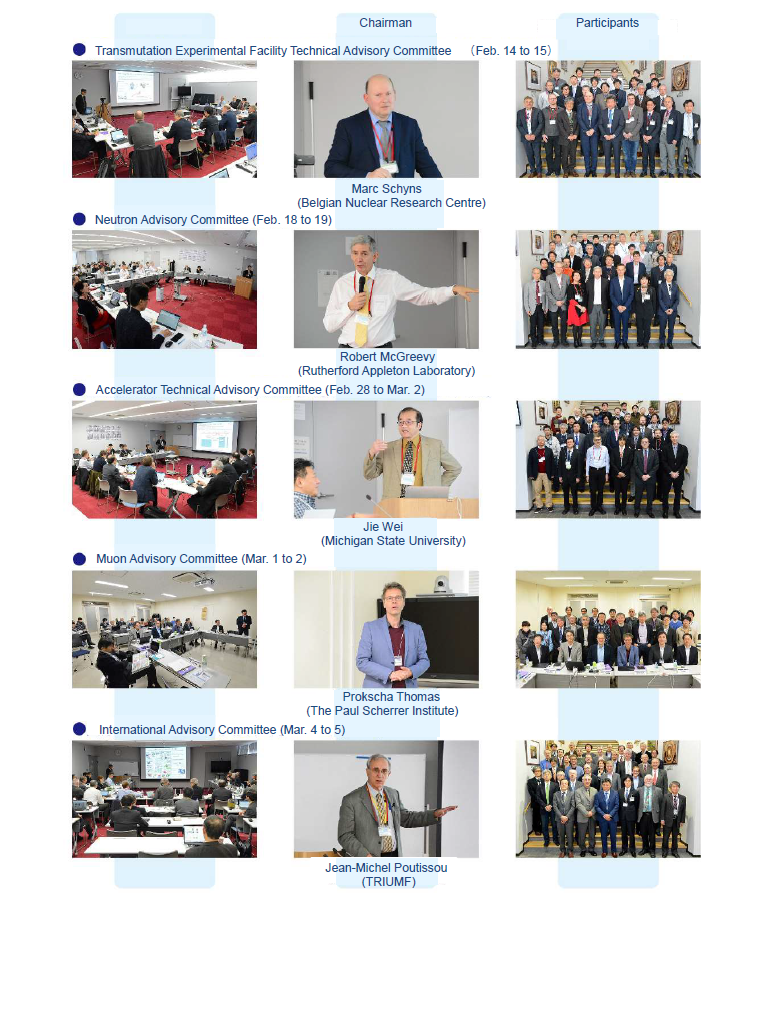
■The Quantum Beam Science Festa 2018, 10th MLF Symposium/36th PF Symposium (March 12 and 13, Tsukuba International Congress Center)
The Quantum Beam Science Festa 2018 was held under the joint auspices of KEK IMSS (Institute of Materials Structure Science) and J-PARC Center MLF. Approximately 580 participants met together, including researchers, engineers, students, or other relevant parties devoted to promoting studies on materials and life science that utilize quantum beam (synchrotron radiation, neutron, muon, slow positron, and so forth). At this Festa, participants presented their research results and discussed the current status and future prospects in the research field. The Festa was held on the first day (March 12) as a joint session and on the second day (March 13) as a parallel session. At the MLF Symposium (Neutron & Muon), the results of user-based research were presented regarding Earth Science and reporting was also made, by both the institutions, regarding the current status of muon production targets and regarding future plans for the high output operation of mercury target systems, followed by lively questions and answers. In addition, Masayasu Takeda from JAEA, presented his lecture about the current status of JRR-3, whose operation they aim to resume by the end of 2020.
■Okayama University Signed the MOU Towards Establishing a J-PARC Branch Office (March 14, Tokyo)
On March 14, 2019, the signing ceremony* of "Memorandum of Understanding on Establishing an Education and Research Hub between KEK and Okayama University" was held at Hitotsubashi Hall of Hitotsubashi University and attended by Hirofumi Makino, the President of Okayama University, Masanori Yamauchi, Director General of KEK, Naohito Saito, J-PARC Center Director, and other attendants. Immediately after this signing ceremony, another new J-PARC branch office, J-PARC Center Okayama University Branch, will be established within the KEK Tokai #1 Building. This is expected to provide a good opportunity for every researcher and student of the university engaged in research at J-PARC to realize convenience in their activities as well as for J-PARC to utilize the university's knowhow and to develop the related research fields, which will result in further promotion of education and research. Okayama University has been promoting collaborative research such as neutrino experiments (T2K) at J-PARC and various types of studies at MLF that utilize neutrons and muons. As a result of the establishment of this J-PARC branch office, the J-PARC Center and Okayama University will collaborate much more closely in research with each other.
* Previous related memoranda of understanding were signed with Osaka University in March 2016, with Kyoto University in February 2017, Kyushu University in March 2018, and with Nagoya University in October 2018.
■J-PARC Hello Science - Visualization of Secondary Lithium-Ion Batteries Using Neutron Beam - (February 22, Industry and Information Plaza "iVil" in Tokai Village)
Another Science Café held in February welcomed Masao Yonemura from the Neutron Science Section, to give a lecture on the forefront of research and development of batteries that utilize neutron beams created at MLF's Special Environment Neutron Diffractometer (BL09 SPICA). From the point of view of a battery's deterioration and safety, the lecturer explained what reaction would take place inside a widely-used lithium-ion secondary battery and what to do to improve its performance, while showing the data obtained as a result of observing in real time how the electrode structure changes during the charge and discharge of the battery. In the topic of all-solid-state batteries, called next-generation battery, the following points were raised: the studies have significantly evolved on the visualization of ions moving inside solid lithium-ion conductor materials, which are used instead of conventional electrolyte solution, and therefore, in several years, the development of solid-state battery mounted on vehicles will be accelerated for industrial applications. The lecturer answered many questions from the floor, about the reliability in performance of the commercialized batteries and about their quality evaluation methods.
■Interesting Research Lectures Presented at the 13th Tokai Forum "From Heisei to the Next Era: Future Prospects for JAEA Tokai Area" (February 28, Industry and Information Plaza "iVil" in Tokai Village)
On February 28th, the Japan Atomic Energy Agency (JAEA) held another Tokai Forum at "iVil", in order to provide the residents in the area detailed reporting on the current status and future prospects for the JAEA Tokai Area. At the forum, J-PARC Center Director Naohito Saito made a report about the overview of the center; in addition, Asami Sano, the Neutron Science Section's Assistant Principal Researcher, gave a lecture on the subject of "High-Pressure Earth Science that Utilizes Neutrons - Aiming at Better Understanding of the Water Planet, Earth". She introduced a part of their research work: their research utilizes a high-pressure neutron diffractometer (BL11 PLANET) at MLF, which is able to create a more intensive testing environment (under a pressure of 200,000atm/at several thousand degrees Celsius) on the ground, and focuses on the elucidation on how the deepest part of the Earth appears to be.

